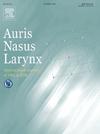莫匹罗星软膏与碱性成纤维细胞生长因子凝胶治疗小儿复发性前鼻出血的比较:随机、对照、单盲研究。
IF 1.5
4区 医学
Q2 OTORHINOLARYNGOLOGY
引用次数: 0
摘要
目的:本研究的目的是比较莫匹罗星软膏(2%)(MUO)和重组牛碱性成纤维细胞生长因子眼凝胶(bFGF)治疗儿童复发性前鼻出血(RAE)的中短期疗效。材料与方法:将RAE患儿随机分为MUO组和bFGF组。比较两组患者鼻衄复发、鼻衄严重程度评分(ESS)和视觉模拟评分(VAS)在4周和3个月的差异。结果:本研究纳入371例RAE患儿。治疗后4周,MUO组鼻出血复发率为44.57%,bFGF组为30.81% (P < 0.05)。治疗后3个月,MUO组鼻出血复发率为63.59%,bFGF组为28.65% (P < 0.001)。此外,MUO组治疗后4周AR与非AR患者的鼻出血复发率差异无统计学意义(P < 0.05), bFGF组治疗后4周AR与非AR患者的鼻出血复发率差异无统计学意义(P < 0.309)。在MUO组中,42.5%的患者报告鼻腔刺痛,70.4%的患者报告不适,而bFGF组中没有任何患者报告鼻腔刺痛。此外,在每个随访时间点,bFGF组的ESS平均评分均显著低于MUO组。鼻痒或鼻痂的VAS评分,bFGF组在4周和3个月时的改善优于MUO组。结论:与莫匹罗星软膏相比,bFGF凝胶治疗儿童RAE的复发性鼻出血率更低,中短期疗效更好,且bFGF无鼻腔刺痛和不适,患儿依从性好。本文章由计算机程序翻译,如有差异,请以英文原文为准。
Comparison of Mupirocin ointment and basic fibroblast growth factor gel in the treatment of pediatric recurrent anterior epistaxis: Randomized, controlled, single blind study
Objective
The objective of this study was to compare the short-and medium-term effectiveness of Mupirocin ointment (2 %) (MUO) and recombinant bovine basic fibroblast growth factor eye-gel (bFGF) in the treatment of recurrent anterior epistaxis (RAE) in children.
Material and methods
children with RAE were randomly allocated into MUO group or bFGF group. The recurrence epistaxis,epistaxis severity score (ESS),and visual analog scale (VAS) were compared among two groups at 4 weeks and 3 months.
Results
This study included 371 children with RAE.The recurrence epistaxis was 44.57 % in the MUO group and 30.81 % in the bFGF group at posttreatment 4 weeks (P < 0.05). Also, the recurrence epistaxis rate was 63.59 % in the MUO group and 28.65 % in the bFGF group at posttreatment 3 months (P < 0.001). Furthermore, in the MUO group, there was not significant difference in the recurrence epistaxis rate between the patients with AR and non-AR at posttreatment 4 weeks (P > 0.05), while there was not significant difference in the recurrence epistaxis rate between the patients with AR and non-AR at posttreatment 4 weeks (P = 0.309) in the bFGF group. In the MUO group, 42.5 % patients reported the pricking of nasal cavity and discomfort in 70.4 %, whereas no any patients did in the bFGF group. Moreover, at each follow-up time point, the mean ESS score in the bFGF group was significantly lower than that in the MUO group.VAS scores for itchy nose or nasal crusts, the improvement in the bFGF group was better compared with the MUO group at 4 weeks and 3 months.
Conclusion
bFGF Gel has a lower rate of recurrent epistaxis and better short-and medium-term effectiveness in the treatment of RAE in children compared with Mupirocin ointment, additionally, bFGF has no the pricking and discomfort of nasal cavity,thus resulting in well children's compliance.
求助全文
通过发布文献求助,成功后即可免费获取论文全文。
去求助
来源期刊

Auris Nasus Larynx
医学-耳鼻喉科学
CiteScore
3.40
自引率
5.90%
发文量
169
审稿时长
30 days
期刊介绍:
The international journal Auris Nasus Larynx provides the opportunity for rapid, carefully reviewed publications concerning the fundamental and clinical aspects of otorhinolaryngology and related fields. This includes otology, neurotology, bronchoesophagology, laryngology, rhinology, allergology, head and neck medicine and oncologic surgery, maxillofacial and plastic surgery, audiology, speech science.
Original papers, short communications and original case reports can be submitted. Reviews on recent developments are invited regularly and Letters to the Editor commenting on papers or any aspect of Auris Nasus Larynx are welcomed.
Founded in 1973 and previously published by the Society for Promotion of International Otorhinolaryngology, the journal is now the official English-language journal of the Oto-Rhino-Laryngological Society of Japan, Inc. The aim of its new international Editorial Board is to make Auris Nasus Larynx an international forum for high quality research and clinical sciences.
 求助内容:
求助内容: 应助结果提醒方式:
应助结果提醒方式:


